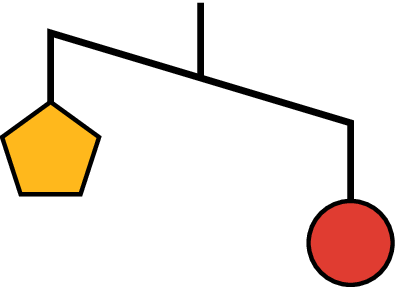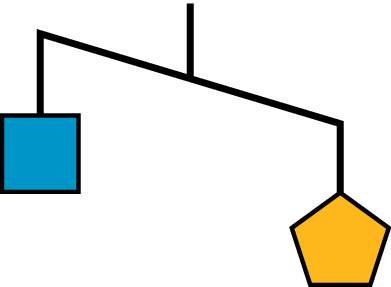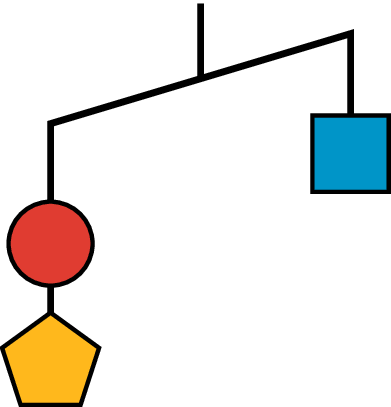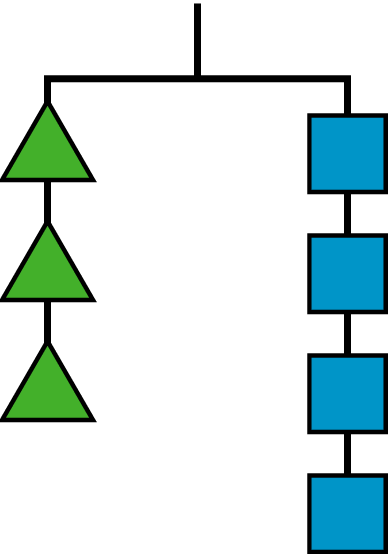Lesson 3
Interpreting Inequalities
3.1: True or False: Fractions and Decimals (5 minutes)
Warm-up
The purpose of this warm-up is to encourage students to reason about properties of operations in equivalent expressions. While students may evaluate each side of the equation to determine if it is true or false, encourage students to think about the properties of arithmetic operations in their reasoning (MP7).
Launch
Display one problem at a time. Tell students to give a signal when they have decided if the equation is true or false. Give students 1 minute of quiet think time and follow with a whole-class discussion.
Student Facing
Is each equation true or false? Be prepared to explain your reasoning.
- \(3(12+5) = (3\boldcdot 12)\boldcdot (3\boldcdot 5)\)
- \(\frac13\boldcdot \frac34\) = \(\frac34\boldcdot \frac26\)
- \(2\boldcdot (1.5)\boldcdot 12\) = \(4\boldcdot (0.75)\boldcdot 6\)
Student Response
For access, consult one of our IM Certified Partners.
Activity Synthesis
Ask students to share their strategies for each problem. Record and display their explanations for all to see. After each true equation, ask students if they could rely on that same reasoning to think about or solve other problems that are similar in type. After each false equation, ask students how we could make the equation true.
To involve more students in the conversation, consider asking:
- “Do you agree or disagree? Why?”
- “Who can restate ___’s reasoning in a different way?”
- “Does anyone want to add on to _____’s reasoning?”
3.2: Basketball Game (15 minutes)
Activity
Students interpret inequalities that represent constraints or conditions in a real-world problem. They find solutions to an inequality and reason about the context’s limitations on solutions (MP2).
Launch
Allow students 10 minutes quiet work time to complete all questions followed by whole-class discussion.
Supports accessibility for: Visual-spatial processing; Organization
Student Facing
Noah scored \(n\) points in a basketball game.
- What does \(15 < n\) mean in the context of the basketball game?
- What does \(n < 25\) mean in the context of the basketball game?
-
Draw two number lines to represent the solutions to the two inequalities.
-
Name a possible value for \(n\) that is a solution to both inequalities.
-
Name a possible value for \(n\) that is a solution to \(15 < n\), but not a solution to \(n < 25\).
- Can -8 be a solution to \(n\) in this context? Explain your reasoning.
Student Response
For access, consult one of our IM Certified Partners.
Anticipated Misconceptions
Students might have trouble interpreting \(15 < n\) because of the placement of the variable on the right side of the inequality. Encourage students to reason about the possible values of \(n\) that would make this inequality true.
Activity Synthesis
Invite selected students to justify their answers. Extend the discussion of the basketball game to consider how scoring works and whether any number could represent the points scored by a player. For example, could a player have scored 1 point? \(2\frac12\) points? 0 points? -3 points? Is it reasonable for a player to score 200 points in a game?
Design Principle(s): Optimize output (for explanation)
3.3: Unbalanced Hangers (15 minutes)
Activity
In this activity, students describe unbalanced hanger diagrams with inequalities. Students construct viable arguments and critique the reasoning of others during partner and whole-class discussions about how unknown values relate to each other (MP3).
Launch
Arrange students in groups of 2. Give students 7 minutes quiet work time, followed by 3–5 minutes for partner discussion. Tell students to check in with their partners and, if there are disagreements, work to come to an agreement. Follow with whole-class discussion.
Supports accessibility for: Organization; Attention
Student Facing
-
Here is a diagram of an unbalanced hanger.

-
Jada says that the weight of one circle is greater than the weight of one pentagon. Write an inequality to represent her statement. Let \(p\) be the weight of one pentagon and \(c\) be the weight of one circle.
-
A circle weighs 12 ounces. Use this information to write another inequality to represent the relationship of the weights. Then, describe what this inequality means in this context.
-
-
Here is another diagram of an unbalanced hanger.

-
Write an inequality to represent the relationship of the weights. Let \(p\) be the weight of one pentagon and \(s\) be the weight of one square.
-
One pentagon weighs 8 ounces. Use this information to write another inequality to represent the relationship of the weights. Then, describe what this inequality means in this context.
-
Graph the solutions to this inequality on a number line.
-
- Based on your work so far, can you tell the relationship between the weight of a square and the weight of a circle? If so, write an inequality to represent that relationship. If not, explain your reasoning.
-
This is another diagram of an unbalanced hanger.

Andre writes the following inequality: \(c + p < s\). Do you agree with his inequality? Explain your reasoning.
- Jada looks at another diagram of an unbalanced hangar and writes: \(s + c > 2t\), where \(t\) represents the weight of one triangle. Draw a sketch of the diagram.
Student Response
For access, consult one of our IM Certified Partners.
Student Facing
Are you ready for more?
Here is a picture of a balanced hanger. It shows that the total weight of the three triangles is the same as the total weight of the four squares.

- What does this tell you about the weight of one square when compared to one triangle? Explain how you know.
- Write an equation or an inequality to describe the relationship between the weight of a square and that of a triangle. Let \(s\) be the weight of a square and \(t\) be the weight of a triangle.
Student Response
For access, consult one of our IM Certified Partners.
Activity Synthesis
The purpose of the discussion is to let students explain how they used inequalities to compare the weights of different shapes on the hanger diagrams. Invite groups to describe any disagreements or difficulties they had and how they resolved them. Select students to share how they reasoned about the quantities when there were two or more unknowns. Ask students if they can think of other situations comparing two or more unknown quantities (people’s heights, weights of backpacks). Invite them to represent the quantities with variables and write inequality statements to compare them.
If time allows, display a circle opposite a pentagon and square for all to see. Ask students which side they think would be heavier. In this case, which side is heavier depends on how much the square weighs. Since the circle is 12 ounces and the pentagon is 8 ounces, the square would have to be less than 4 ounces for the circle to be heavier and greater than 4 ounces for the pentagon and square to be heavier.
Design Principle(s): Support sense-making; Maximize meta-awareness
Lesson Synthesis
Lesson Synthesis
Ask students to think about situations where limits or ranges of values can be important to public health or safety (e.g., weight limitations on an elevator, safe dosage for medication, tire pressure, speed limit, temperature for growing carrots, etc.). Ask them to define variables and write inequalities to represent these situations. Select 2 or 3 students to share their responses. Record and display those responses for all to see using the appropriate symbols. Here are some questions to consider during discussion:
- “Do solutions that are not whole numbers make sense in this situation?”
- “Do solutions that are negative numbers make sense in this situation?”
- “Do the numbers on the boundary count as solutions? For example, if an elevator has a maximum capacity of 2,500 pounds, can it handle exactly 2,500 pounds?”
3.4: Cool-down - Lin and Andre’s Heights (5 minutes)
Cool-Down
For access, consult one of our IM Certified Partners.
Student Lesson Summary
Student Facing
When we find the solutions to an inequality, we should think about its context carefully. A number may be a solution to an inequality outside of a context, but may not make sense when considered in context.
- Suppose a basketball player scored more than 11 points in a game, and we represent the number of points she scored, \(s\), with the inequality \(s >11\). By looking only at \(s >11\), we can say that numbers such as 12, \(14\frac12\), and 130.25 are all solutions to the inequality because they each make the inequality true.
\(\displaystyle 12>11\)
\(\displaystyle 14\frac12 >11\)
\(\displaystyle 130.25 > 11\)
In a basketball game, however, it is only possible to score a whole number of points, so fractional and decimal scores are not possible. It is also highly unlikely that one person would score more than 130 points in a single game.
In other words, the context of an inequality may limit its solutions.
Here is another example:
-
The solutions to \(r<30\) can include numbers such as \(27\frac34\), 18.5, 0, and -7. But if \(r\) represents the number of minutes of rain yesterday (and it did rain), then our solutions are limited to positive numbers. Zero or negative number of minutes would not make sense in this context.
To show the upper and lower boundaries, we can write two inequalities:
\(\displaystyle 0< r\)
\(\displaystyle r<30\)
Inequalities can also represent comparison of two unknown numbers.
- Let’s say we knew that a puppy weighs more than a kitten, but we did not know the weight of either animal. We can represent the weight of the puppy, in pounds, with \(p\) and the weight of the kitten, in pounds, with \(k\), and write this inequality: \(\displaystyle p >k\)